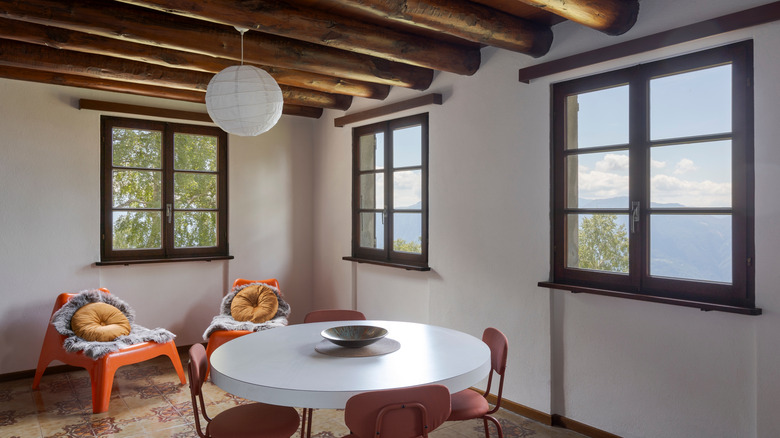The Real Reason Your House Has Such Low Ceilings
We may receive a commission on purchases made from links.
Ceilings are one architectural feature that's easy to overlook, unless yours are extremely low. Today, it's common for new-construction homes to have 8-, 9-, or 10-foot ceilings, and in vaulted entryways or great rooms, ceiling heights can soar up to 25 feet. Color drenching with paint, installing stamped tiles, and hanging wallpaper are among the eye-catching ways to decorate ceilings. Using more than basic white on the "fifth wall" is a popular home decor trend that shows no sign of stopping, thanks to its ability to make larger rooms feel more cozy and intimate. But what should you do when your house has low ceilings?
House Digest spoke with design historian Sarah Bilotta to understand the real reasons why some houses were built with low ceilings and how to make the most of them. "In the past, it was more economically advantageous to build smaller homes. The purpose for this was twofold: to use fewer supplies and to maximize heating," Bilotta explained.
The expert went on to say it wasn't always the case that older homes had low ceilings in every room, especially with manor homes designed to showcase their owner's wealth or status: "The ground floor of a country manor in Georgian England typically had ceilings of 10 feet high or more ... However, on the upper floors, you were more likely to see ceilings 6 to 8 feet in height, in private spaces only occupied by the family."
Low ceilings are cheaper to build but come with design challenges
"The heights of ceilings in homes fluctuate in times of economic upheaval, and also vary widely among people in different regions of the country and different economic situations," Sarah Bilotta told House Digest in an exclusive interview. According to the design historian, higher ceilings became the norm around the 1990s. "With more efficient heating systems, standard heights of doors and built-in furnishings have accordingly changed to produce more expansive-feeling interiors," she said. "It seems there's no going back now — even with the rising cost of building supplies!"
If you live in an older or historical home, you may be wondering why your house has low ceilings because you're having a hard time decorating or you feel cramped in the space. Bilotta acknowledged these downsides, but she explained that they can be overcome with a thoughtful approach to design: "Decorating with wall art or hanging a television on the wall can be a nuisance, as you find yourself with less wall space to work with and thus a smaller buffer between eye level and the ceiling."
The expert also said lighting is more challenging. "Taller lamps and brighter bulbs may reflect abrasively direct light upon the ceiling, and pendant lamps are likely to knock you in the head," she said. If you really want to add statement lighting, a narrow, cascading fixture, like the dolria Modern Crystal Pendant Light from Amazon, is a dramatic choice that can make low ceilings look taller.
Do's and don'ts for designing a low-ceilinged room
There are also other tricks for designing a low-ceilinged room that can make your space feel larger. In her exclusive interview with House Digest, Sarah Bilotta offered several simple suggestions. "Hang artwork and mirrors slightly above eye level, to draw the eye upward," she said. Bilotta also recommended hanging curtains at ceiling level instead of at the top of your windows.
The design historian cautioned against finishes like limewash or stucco: "Don't add texture or pattern to the ceiling ... This will only make the space feel fuller." You should also avoid that full effect by selecting the right furniture. Bilotta said to pick "proportional" pieces, like narrow shelves and low seating, such as the highly rated CHITA Swivel Accent Chair from Amazon.
If you're constantly bumping your head or feeling claustrophobic in your low-ceilinged rooms, you may want to actually raise the ceilings. Think long and hard before you do. "While this is possible, it can be very work-intensive," Bilotta forewarned. "Whether or not it's worth it depends on your individual situation." The expert advised that if you're living in a historical home that needs insulation added, that may be a good time to raise the ceiling. She also pointed out, "Raising the ceiling of an upper floor by expanding into the attic is typically easier than raising the ceiling on a lower floor, where you have to take into consideration the structural elements of the second floor."


